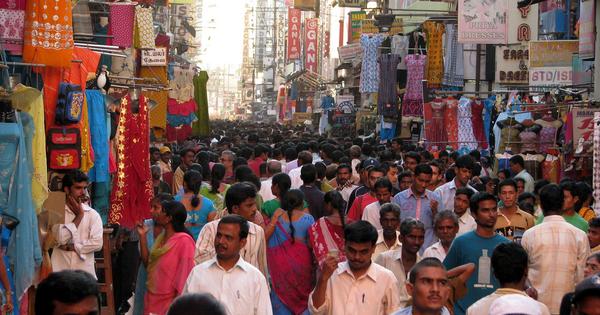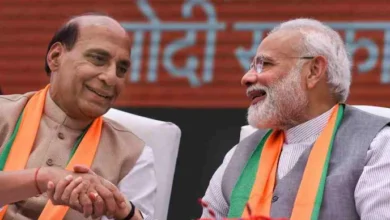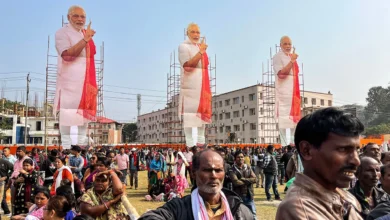
According to a study conducted by the Economic Advisory Council to the Prime Minister (EAC-PM), the population share of Hindus, who make up the majority religion in India, fell precipitously by 7.8% between 1950 and 2015, whereas the population of the predominant community in several adjacent nations increased.
The proportion of minorities in India, such as Muslims, Christians, Buddhists, and Sikhs, increased while the Hindu population declined. But the proportion of Jains and Parsis in the population fell.
In India, the percentage of Muslims increased by 43.15% between 1950 and 2015, whereas the percentage of Christians, Sikhs, and Buddhists increased by 5.38%, 6.58%, and slightly by 1.
According to the EAC-PM study, the proportion of Hindus in India’s population decreased from 84% in 1950 to 78% in 2015, while the proportion of Muslims increased over the same 65-year period from 9.84% to 14.09%.
India’s population contraction (by 7.8%) is the second largest fall in the immediate vicinity, only surpassed by Myanmar’s (10%).
The Hindu majority community in Nepal experienced a 3.6% decrease in its population share, the only exception being India.
The study evaluated the patterns in 167 different countries worldwide, and its result was published in May 2024.
“India’s performance is consistent with the larger global trends,” the study’s authors write.
“Contrary to the noise in several quarters, careful analysis of the data shows that minorities are not just protected, but indeed thriving in India,” according to the researchers.
India’s demographic growth narrative differs significantly from those of its neighbouring countries.
Between 1950 and 2015, the population of the Hindu community, which makes up the majority of Indians, decreased by 7.8%. However, the community’s proportion in the demographic mix increased in the neighbouring nations where Muslims make up the majority.
The countries with the biggest increases were Bangladesh (18.5%), Pakistan (3.75%), and Afghanistan (0.29%).
“Pakistan witnessed an increase of 3.75% in the share of the majority religious denomination (Hanafi Muslim) and a 10% increase in the share of the total Muslim population despite the creation of Bangladesh in 1971,” noted the study co-authored by Shamika Ravi, Abraham Jose and Apurv Kumar Mishra.
The largest fall in the percentage of the majority community living in India’s vicinity was observed in Myanmar, India’s eastern neighbour. In 65 years, the majority Theravada Buddhist population in Myanmar decreased by 10%.
The EAC-PM survey found that, in addition to India and Myanmar, Nepal had a 3.6% decrease in its predominately Hindu population.
The Shafi’i Sunni majority group’s percentage decreased by 1.47% in the Maldives.
However, the report published in May 2024 also found that Bhutan and Sri Lanka, two of India’s neighbours with a predominately Buddhist population, saw increases of 17.6% and 5.25%, respectively.
“The change in the proportion of minorities as a share of the total population serves as a reliable proxy for the status of minorities in a country, which is fostered through policies including defining minorities, which itself is a rare practice globally,” said the study, which assessed the trends in 167 countries globally.
The analysis concludes that the shift in India’s population is consistent with the global trend of a shrinking majority. In certain instances, such as in Australia, China, Canada, New Zealand, and a few east African countries, the decline in the population proportion of the majority community was more severe than it was in India.
“The share of the majority religious denominations in 167 countries has, on average, reduced by 22% from 1950-2015. The change varies from a 99% decrease in Liberia to an 80% increase in Namibia. 123 countries experienced a decrease in the share of the majority denomination,” noted the study.
Furthermore, the percentage of the dominant religion decreased significantly on average by 29% in the 35 wealthy Organisation for Economic Co-operation and Development (OECD) countries, outpacing the global average of 22%.
A global organisation of 38 free-market western nations, the OECD was founded in 1989.
Nevertheless, the study made it clear that its goal was to determine if minorities were becoming more or less represented in society by looking at the numbers rather than attempting to understand why these changes were occurring.
“A decrease in the share of the majority population and a consequent increase in the share of minorities suggests that the net result of all policy actions, political decisions and societal processes is to provide a conducive environment for increasing diversity in society,” says the study by the PM’s economic council.
According to the writers, “there is a conducive environment to foster diversity in the society” based on the trend in India.
The report praises India’s institutions and policies for improving the lot of its minorities.



